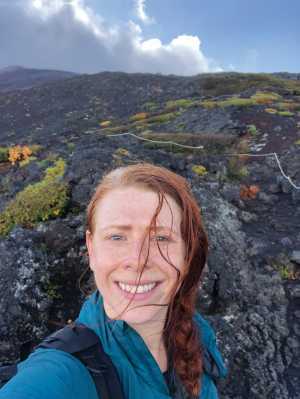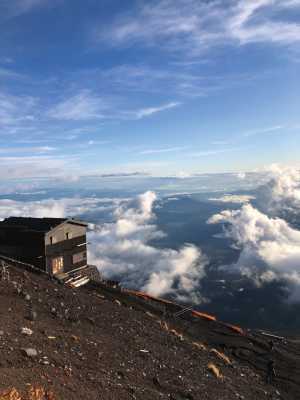The day we began climbing Mount Fuji, a thick, stubborn cloud was clinging to the mountain. And I, a thick, stubborn Canadian, wasn’t about to let some fog and a bout of bronchitis stand between me and summiting my first peak.
Since landing in Hiroshima, my friend Cara and I had biked 130 kilometres through a heatwave, taken the long route up Misen (three kilometres of steep, shine-dotted stairs), watched a Rugby World Cup game, and walked through six cities until our feet blistered. I don’t know if it was the non-stop activity, the circadian rhythm-wrenching time change or the too-many consolation beers consumed while we watched the All Blacks’ bench warmers crush the Canadian rugby team, but by the time we got to Osaka I was a feverish, wheezing husk.
When I was eight I contracted whooping cough and since then, I’ve had garbage lungs. For years, asthma kept me from enjoying sports, until I got it under control in my twenties. But almost every autumn I come down with either bronchitis or pneumonia. The timing, though, couldn’t be worse: I was about to climb my first legitimate has-a-peak-above-the-treeline mountain.
Mount Fuji’s climbing season is short, just July to early September. During this nine-week window, Japan’s holiest mountain is slammed with humans. It’s an ant line of trekkers stepping on each other’s heels as they march one-by-one to the top. Swarmed with visitors, the mountain loses some of its magic. It’s possible to climb during the off-season, but it can be treacherous for the inexperienced. Scaling Fuji outside the summer is ill-advised as the huts are closed, temperatures sit well below freezing, winds whip, and should anything go wrong, medical aid will be slow to arrive.
Just a few weeks after our trip up Fuji, an inexperienced climber was live-streaming his attempt to brave the snow-covered, 27-degree gradient when he tragically fell. Although it’s a fairly straightforward climb, Fuji is extremely steep and slipping off the trail can result in serious injury or, as was the case for this Japanese YouTuber, death. Falling stones and exposure have also taken a number of lives. Most fatalities, though, are due to cardiac episodes. Because Fuji isn’t too challenging, a number of people attempt the ascent who are maybe not quite fit enough to surmount 3,776 metres of elevation.
Cara and I weren’t concerned. She’s an avid outdoors person who had previously tackled Hawaii’s Mauna Loa and Mount Teide in the Canary Islands, and I’m a fitness fanatic that thinks a five-kilometre run is a rest day. The trek to the top would be frosty but with proper gear and a guide the hike should be tough but doable.
The night before our climb we slept in Gotemba, a quaint, alpine town at the foot of Mount Fuji. Hoping soup would kick my cough to the curb, we popped into a cozy-looking ramen shop. Halfway through dinner, a trio of brash, blond buzz-cuts came crashing through the door. From across the restaurant, they conversed at us: “We don’t have a permit or plan, really, just gonna drive up as far as we can and then start climbing,” said one of the U.S. army boys. They scoffed at us when we told them that we had opted to pay ¥50,000 ($600) to climb with Fuji Mountain Guides.
For us, it was worth it. Not only would we be able to rent some of the necessary gear – so, no lugging boots and poles across Japan for 16 days – but the package also included pickup from the train station, mountain fees, an overnight stay in the mountain’s only autumn-operating hut and three meals.
The next morning, I woke up feeling worse. My voice was a garbled croak and my head felt like a shaken soft drink. Soup. I needed more soup. After soup I would decide if I was abandoning Cara to climb Fuji on her own. After buying four litres of water and downing two litres of convenience store dashi broth, I decided that the phlegm in my lungs be damned, we’re doing this. Not only was I too cheap to just wave goodbye to $600, but this was probably my only chance to tackle Fuji.
A shuttle scooped us up at the train station. During the 70-minute ride we quickly got to know some of our climbing party. The loudest was a Texan in her mid-thirties, who bragged about her fitness level by telling a story about how she once ditched her “overweight” cousin during a mountain race. Later, she would ditch all of her friends on that bus, too. While I judged the gabby Southerner, my new-found climbing pals surely judged me. My wet coughs even got a few wary looks from the guides as we wound our way up to the base of the mountain.
At Kawaguchiko Fifth Station (one of the huts where you can use the facilities and grab a bite) we were given the Fuji Mountain Guide spiel over comforting bowls of foraged mountain mushroom udon soup: don’t leave the trail, you’ll end up on the other side of the mountain and that’ll be one pricey cab ride back. Expect four seasons in a day – you’ll be hot, you’ll be frozen, you’ll be wet. Bring enough water for your summit and descent, and finally any garbage you bring up must also come down. Then it was off to the races as we began following the Subashiri trail up.
With the heavy fog settling between the gnarled birch trees, climbing through Fuji’s forest felt like winding through a Tolkien scene. The path is black volcanic rock that’s been rubbed smooth by the many feet but it still somehow feels untouched – beyond the trail, everything is wild: the untamed tall grass and oversized thistles are punctuated by pops of orange, deciduous trees. The view is stunning, that is, when you can see anything through the whipped cream clouds.
Whenever we’d arrive at one of the shuttered stations we’d regroup and make the same joke about the fantastic views of white. “At least I can echo-locate you thanks to that cough,” said Cara. Two hours in, our jokes were more tired than we were, and I was exhausted and trying to hide my gasping breaths. The bronchitis had pushed my heart rate into the 160s, but I refused to slow my pace for no real reason other than that I’m a proud and stubborn masochist that didn’t want to fall to the back of the pack.
Once we passed the treeline, Fuji’s spell had lifted. I was no longer hypnotized by the entrancing flora – now, just a few squat bushes dotted the volcanic gravel-covered incline. With no distractions, I realized I was miserable: soaked from the fog and aching from the weight of the water-filled backpack.
Fortunately, the hut was about an hour away. Unfortunately, this was the steepest section of the climb so far, and those of us sensitive to altitude sickness began to suffer. Cara and I were fine, although she had taken a tumble earlier when one of her hiking poles collapsed. Whenever I would check in – she was lagging behind – her face would wrinkle into her “I’m fine, leave me alone” look.
One of the first rules I would learn at the hut was that hang-drying clothes was forbidden. If I wanted a dry jacket for tomorrow’s ascent, the suggestion was to sleep in my wet clothes as they’d dry overnight with my body heat – otherwise all wet items were banished into plastic bags. The second rule of the hut is there’s no such thing as personal space (we would be sleeping four to a bunk and lights out was 8:30 p.m.).
After dinner – including all-you-can-eat cabbage soup, and yes, I went back for fourths because antibiotics be damned, the healing powers of soup were gonna get me up this mountain – the guides were talking with each other about doing a few strength exercises. “Can I join in?” I asked, thinking that if I got my blood pumping my clothes might dry off. Soon, we were doing pull-ups on the bunk beds, and using each other as human weights for calf raises and squats. By bedtime, my coughs had abated and I’d traded sodden for merely moist.
At 4 a.m., we were told to rise and shine, but there was no shine as it was still pitch-black outside. After a breakfast of soup(!), salmon and rice, we headed out: me still hacking and Cara limping slightly. As we began climbing, the sun rose beneath us, breaking through a layer of plump, stratus clouds. Once the selfies had all been snapped, we clicked into high gear. If we didn’t want to be soggy, we needed to stay ahead of that rising mist. Although our speed resulted in an hour of pleasant views, soon the temperature began to drop, the wind to whip, and eventually we were once again trudging through white haze.
I was losing steam – the top could be within reach or another hour’s climb for all I knew. We could barely see five feet in front of us, let alone the peak. Finally, a torii gate flanked by two komainu (lion-dog) sculptures signalled that Fuji’s inner shrine – the whole mountain is a holy site – was close by. Although I’m not particularly spiritual, I said a small prayer of thanks to the mountain gods before making my way through the gate and up to the summit.
After quickly downing a glass of celebratory, 7 a.m. sake, it was time to descend. The path down is a steep, scree-covered switchback. Somewhere between slaloming through the loose volcanic pebbles and trying not to fall on my face, I realized my cough was pretty much gone. Maybe it was the magic of Mount Fuji, or maybe it was the copious quantities of steaming soup, but by the time we got down the mountain I was feeling like 100 yen again.


